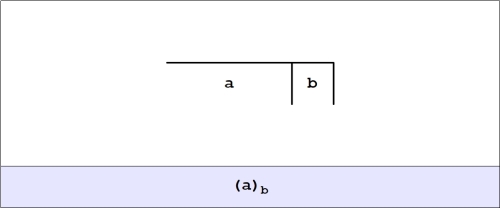A funny thing just happened. Let’s see if we can tell where. We started with the algebraic expression in which the operand
suggests the contemplated absence or presence of any arithmetic expression or its value, then we contemplated the absence or presence of the operator
in
to be indicated by a cross or a space, respectively, for the value of a newly introduced variable,
placed in a new slot of a newly extended operator form, as suggested by the following picture.
What happened here is this. Our contemplation of a constant operator as being potentially variable gave rise to the contemplation of a newly introduced but otherwise quite ordinary operand variable, albeit in a newly-fashioned formula. In its interpretation for logic the newly formed operation may be viewed as an extension of ordinary negation, one in which the negation of the first variable is controlled by the value of the second variable.
We may regard this development as marking a form of controlled reflection, or a form of reflective control. From here on out we’ll use the inline syntax to indicate the corresponding operation on two variables, whose formal operation table is given below.
- The Entitative Interpretation
for which Space = False and Cross = True,
calls this operation equivalence. - The Existential Interpretation
for which Space = True and Cross = False,
calls this operation distinction.
cc: Cybernetics (1) (2) • Peirce (1) (2) (3) (4) (5) (6) (7) (8) (9) (10) (11) (12) (13) (14)
cc: Ontolog Forum (1) (2) • Structural Modeling (1) (2) • Systems Science (1) (2)
cc: FB | Logical Graphs • Laws of Form



Pingback: Survey of Animated Logical Graphs • 2 | Inquiry Into Inquiry
Pingback: Animated Logical Graphs • 29 | Inquiry Into Inquiry
Pingback: Animated Logical Graphs • 31 | Inquiry Into Inquiry
Pingback: Survey of Animated Logical Graphs • 2 | Inquiry Into Inquiry
Pingback: Survey of Animated Logical Graphs • 3 | Inquiry Into Inquiry
Pingback: Differential Propositional Calculus • Discussion 4 | Inquiry Into Inquiry
Pingback: Animated Logical Graphs • 68 | Inquiry Into Inquiry
Pingback: Animated Logical Graphs • 22 | Inquiry Into Inquiry
Pingback: Animated Logical Graphs • 29 | Inquiry Into Inquiry
Pingback: Survey of Animated Logical Graphs • 4 | Inquiry Into Inquiry
Pingback: Survey of Animated Logical Graphs • 5 | Inquiry Into Inquiry
Pingback: Survey of Animated Logical Graphs • 6 | Inquiry Into Inquiry
Pingback: Survey of Animated Logical Graphs • 7 | Inquiry Into Inquiry